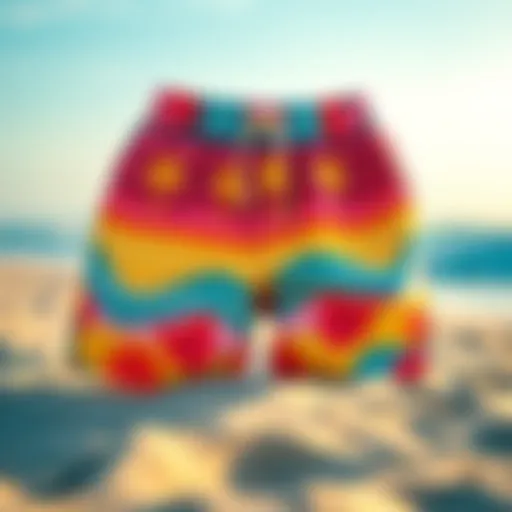Neoprene-Free Wetsuits: Sustainable Surfing Gear


Intro
As surfers embrace the call of the ocean, they often face a dilemma: balancing performance with environmental responsibility. In recent years, a wave of innovation has surged through the surf gear industry, notably in the realm of wetsuits. Traditional neoprene wetsuits are known for their warmth and flexibility, yet the production of neoprene involves environmentally damaging processes and releases significant greenhouse gases. With a growing awareness around sustainability, surfers are now considering exfoliating their dependency on neoprene. This is where neoprene-free wetsuits step in, offering a promising alternative.
Not only do these wetsuits aim to minimize environmental impact, but they also provide a myriad of benefits—from increased comfort to enhanced agility in the water. But what exactly makes these alternatives stand out? As we venture deeper into this topic, we'll explore the materials used in neoprene-free wetsuits, their advantages, and their implications for both surfers and the ocean.
Surf Gear and Equipment
Materials Behind Neoprene-Free Wetsuits
Neoprene-free wetsuits are often crafted from materials like natural rubber, a byproduct of the rubber tree, and other innovative textiles that prioritize sustainability without sacrificing quality. The use of natural rubber not only reduces the carbon footprint but also has the added advantage of providing excellent thermal insulation. Another notable contender is Yulex, a plant-based alternative that shows promise in terms of flexibility and durability—qualities surfers know and love.
On the other hand, some brands leverage recycled materials like plastics and fishing nets, demonstrating how industry waste can be repurposed into high-performance surf gear. This circular approach not only saves resources but also encourages a more mindful consumption model within surfing culture.
Performance Factors
When considering a wetsuit, performance becomes a crucial factor. Surfers often worry that switching to a neoprene-free option might mean sacrificing speed or warmth. Contrary to this belief, many leading brands have managed to marry eco-friendliness with high performance. Some alternatives maintain elasticity and warmth comparable to their neoprene counterparts, allowing surfers to ride the waves without compromise.
"Sustainability does not have to edge out performance; it can coexist harmoniously."
For instance, companies like Patagonia and O'Neill have emerged as pioneers in embracing sustainable materials while producing wetsuits that perform exceptionally well in cold waters. Quality should never take a backseat to sustainability, and with these advancements, the industry is proving just that.
Essential Accessories for Surfers
To complement neoprene-free wetsuits, surfers should consider essential accessories that further enhance their experience.
- Surf Caps: These help protect the head from cold water and sun damage without the use of synthetic materials.
- Boots: Look for options made from eco-friendly rubber that provide warmth while being kind to the planet.
- Gloves: An often-overlooked accessory, gloves made from natural materials can prevent numb fingers, keeping surfers warm during those brisk sessions.
Embracing these accessories not only offers additional comfort but also promotes a complete sustainable surfing setup, turning the tide towards a more eco-friendly approach to the sport we love.
Implications for Surfers and the Environment
Adopting neoprene-free wetsuits symbolizes a broader change within the surfing community. It highlights a shift toward valuing sustainable practices and environmental mindfulness. As individual surfers begin to consider the impact of their gear, the industry will likely respond with more sustainable options, paving the way for a greener future.
Additionally, this movement encourages surfers to become advocates for ocean protection and raises awareness about the delicate ecosystems they enjoy. As the tide of sustainability rises, it's essential for surfers to ride this wave, ensuring that both the sport and the environment can flourish in harmony.
Foreword to Neoprene-Free Wetsuits
In the ever-evolving world of surfing gear, the impact of materials on both performance and the environment cannot be overstated. Neoprene-free wetsuits have emerged as a beacon of innovation, signaling a shift towards more sustainable practices within the surfing community. These alternatives not only aim to maintain the necessary comfort and thermal insulation while riding on waves, but they also showcase a commitment to ecological responsibility that increasingly resonates with surfers and outdoor enthusiasts alike. With rising concerns about climate change, it’s vital for surfers to consider the implications of their gear choices.
Definition and Overview
Neoprene, a synthetic rubber widely used in traditional wetsuits, poses significant challenges, particularly when it comes to environmental impact. This material is derived from petroleum, a non-renewable resource, and its production process can lead to harmful emissions. Neoprene-free wetsuits, on the other hand, adopt more sustainable materials, like natural rubber or innovative blends that lessen ecological footprints.
These alternatives often provide similar, if not better, performance characteristics compared to their neoprene counterparts. They are available in various designs and thicknesses tailored to a wide range of water temperatures, meaning surfers can find a suitable option regardless of where they surf. With features like enhanced stretchability and comfort, these suits are suited for anyone from casual beach-goers to professional surfers.
The Evolution of Wetsuit Materials
The journey to develop neoprene-free wetsuits represents a broader trend toward sustainability across various industries. Initially, wetsuits were made from basic materials that lacked the stretch and insulation capabilities needed for aquatic activities. As surfing gained popularity, the industry began adapting, with neoprene becoming the standard material for its impressive insulating properties. However, recognizing the environmental ramifications, innovators began to explore other materials.
In recent years, many brands have dedicated themselves to researching and developing alternatives. Here are a few notable milestones that highlight the evolution:
- Natural Rubber: Sourced from rubber trees, it balances flexibility and warmth. This natural material offers a viable alternative, reducing reliance on synthetic resources.
- Yulex: A patented plant-based material that emphasizes sustainability without sacrificing performance. It's a significant step forward, helping to shrink the carbon footprint.
- Recycled Plastics: Some manufacturers have begun to incorporate recycled ocean plastics into their suits, tackling waste pollution while providing durable outer layers.
"The wave of change we’re seeing in the wetsuit market reflects not just a tech advancement but a deeper commitment to the oceans we surf on."
As brands continue to innovate, it's crucial for surfers to stay informed about the options available and the importance of making eco-conscious choices in their gear selections.
The Environmental Impact of Neoprene
Neoprene, a material synonymous with wetsuits, is not just a surf industry staple but a significant environmental concern. Understanding the ramifications of neoprene production and its lifecycle is crucial for surfers and eco-conscious consumers alike. Its positive aspects in function are often overshadowed by the underlying ecological costs. When surfers opt for neoprene-free alternatives, they take a step towards mitigating these impacts and adopting a more sustainable approach to their passion.
Chemical Composition and Its Consequences
Neoprene, chemically known as polychloroprene, is produced through a complex process involving petroleum products and several harmful additives. The manufacturing of neoprene involves a significant carbon footprint, releasing greenhouse gases that contribute to climate change. Additionally, various byproducts of its production can lead to water pollution, harming both marine and terrestrial ecosystems.
Among the most troubling aspects of neoprene are its properties as a non-biodegradable material. When disposed of improperly, neoprene can persist in landfills for decades, leaching toxic substances into the soil and waterways. Surfers who prioritize sustainability must be aware of such environmental pressures associated with neoprene. While enjoying the waves is exhilarating, using products that inflict long-term damage to the environment is counterintuitive to the ethos of many in the surfing community.
Waste and Recycling Challenges
Recycling neoprene is a Herculean task due to its chemical structure, which is incompatible with traditional recycling methods. When surfers think about the lifecycle of their gear, the challenges become evident. Most waste ends up in landfills, exacerbating the environmental crisis. To illustrate, recent studies indicate that about 95% of used neoprene wetsuits are discarded rather than recycled.


However, strides towards recycling have been made. Some maverick brands are innovating ways to reclaim neoprene from old wetsuits. These initiatives are still in their infancy, which underscores the importance of choosing neoprene-free options that naturally decompose or can be repurposed. The pursuit of sustainable surf gear does not just benefit individual surfers; it has the potential to shift the entire industry towards less harmful practices.
"Choosing neoprene-free wetsuits is not just a personal decision but rather an investment in the health of our planet for future generations."
As surfers seek to connect with the sea, understanding the broader implications of material choices becomes essential. By championing alternatives to neoprene, surfers actively contribute to protecting the delicate ecosystems that they cherish. This shift not only fosters a more sustainable approach to their sport but could pioneer change across the entire surfing culture.
Materials Used in Neoprene-Free Wetsuits
The significance of materials in wetsuits cannot be overstated, especially when it comes to neoprene-free options. As the surf gear industry shifts towards more sustainable practices, choosing the right materials becomes paramount not only for performance but also for environmental impact. Surfers increasingly seek alternatives that maintain comfort while reducing ecological footprints. This section explores the types of sustainable materials available and provides insights into their unique properties and benefits.
Types of Sustainable Materials
Yulex
Yulex is a standout material derived from the sap of the guayule plant. This plant is remarkable for its ability to thrive in arid environments, making it a desirable choice for sustainable sourcing. Unlike traditional neoprene, which has a heavy environmental toll due to its manufacturing process, Yulex is often touted for its lower carbon footprint. One of the key characteristics of Yulex is its natural flexibility and durability, allowing for a snug fit while maintaining freedom of movement.
Moreover, it's a beneficial choice for those who prioritize eco-friendliness without compromising on performance. However, some users report that it may not be as stretchy as traditional neoprene, which can affect overall fit and comfort in certain conditions.
Natural Rubber
Natural rubber, extracted from rubber trees, serves as another eco-conscious alternative to neoprene. This material is praised for its excellent insulation properties and remarkable elasticity, ensuring a comfortable fit even in colder waters. The key characteristic that makes natural rubber a popular choice is its biodegradability, contrasting sharply with neoprene's prolonged environmental impact. Users have noted that it often feels softer against the skin than synthetic alternatives. On the downside, natural rubber can be a bit more sensitive to UV exposure, which may limit its lifespan if not cared for properly.
Recycled Plastics
Recycled plastics are making waves in the wetsuit market, offering an innovative solution for reducing waste. By repurposing materials like used water bottles and discarded fishing nets, this approach not only promotes recycling but also utilizes existing resources efficiently. One major benefit of using recycled plastics is the potential for cost savings in production compared to virgin materials, making it a viable choice for brands looking to reduce expenses while remaining sustainable. However, the challenge lies in the performance; some claims suggest that while these suits are good for the environment, they may not offer the same thermal retention as their natural counterparts. It's crucial for surfers to weigh these factors when selecting their gear.
Comparative Analysis of Materials
When assessing wetsuit materials, a comparative analysis reveals important insights into performance and sustainability. Weighing the benefits and drawbacks helps consumers make informed choices.
Key Comparisons:
- Yulex vs. Neoprene: Yulex is more sustainable; however, it may lack the stretch of neoprene.
- Natural Rubber vs. Neoprene: While natural rubber is biodegradable and comfortable, it requires careful maintenance to protect against UV rays.
- Recycled Plastics vs. Natural Rubber: Recycled plastics use existing resources but might not provide the same insulation as natural rubber.
"Choosing sustainable materials not only enhances your surfing experience but also preserves the ocean for future generations."
Through understanding these materials, surfers can better appreciate the nuances of their choices, paving the way for a more sustainable future in water sports.
Benefits of Neoprene-Free Wetsuits
Neoprene-free wetsuits have emerged as a pivotal advancement in the surfing world, primarily due to their sustainable nature and various advantages they hold over traditional neoprene options. Embracing these alternatives isn't just about keeping pace with trends; it encompasses a holistic approach to surfing that aligns with environmental responsibility and personal well-being. Let's delve into the specific benefits that make neoprene-free wetsuits an important choice for today’s surfers.
Comfort and Fit
The first aspect that stands out when trying neoprene-free wetsuits is comfort. Many users report a notably different sensation when donning these suits, as materials like natural rubber or Yulex feel softer against the skin. This comfort is crucial for long sessions in the ocean, where rubbing seams and stiff materials can lead to annoyance.
Surfers often prefer a snug fit to minimize water entry. Thankfully, many neoprene-free options achieve this without the squeezing effect sometimes associated with neoprene suits. The stretchability and breathability of these eco-friendly materials allow for freedom of movement, allowing surfers to focus on their performance instead of adjusting their gear constantly.
"The moment I slipped into my natural rubber wetsuit, it felt like a second skin—like it was made just for me."
Thermal Insulation Properties
When it comes to thermal insulation, neoprene-free wetsuits can competently hold their own against traditional alternatives. Materials such as Yulex and various blends of recycled plastics have advanced significantly, offering comparable thermal protection while remaining environmentally friendly.
The insulation properties help surfers maintain body warmth in colder waters, which is vital. While traditional neoprene is known for its exceptional thermal retention, newer materials aim to achieve similar levels, ensuring that surfers can stay in the water longer without succumbing to the cold.
Furthermore, the breathability of these materials often leads to less internal condensation. This means that surfers aren't just kept warm; they also enjoy greater comfort as they avoid that clammy feeling that can accompany prolonged use of neoprene suits.
Allergy Considerations
Allergy concerns are worth highlighting when discussing wetsuit materials. Neoprene often contains various chemical additives, which can trigger allergic reactions in some individuals. For those who struggle with skin sensitivity, neoprene-free wetsuits present an attractive alternative. They frequently rely on natural ingredients, which are less likely to provoke skin irritation.
This shift does not only enhance comfort—it also contributes to peace of mind for surfers wary of rashes and discomfort that can result from extended wear of traditional wetsuits. By opting for materials such as natural rubber, there's a noticeable reduction in allergic reactions, making the sport more accessible to everyone.
The integration of eco-friendly manufacturing processes also plays a role in reducing potential health risks, as brands work to eliminate harmful chemicals from their production lines. This combination of comfort, insulation, and lower allergy risk makes neoprene-free wetsuits not just a choice but a smarter, more conscientious one for modern surfers.
Evaluating Performance: How Do They Stack Up?
Understanding performance in neoprene-free wetsuits is crucial, especially for surfers who rely on their gear for an optimal experience in the water. Few factors are as vital as how well a wetsuit integrates comfort, warmth, and flexibility. These aspects influence not just how a surfer feels during their session but also their overall enjoyment and capabilities on the waves. As the conversation around sustainability grows louder, so does the scrutiny on how these eco-friendly alternatives hold up against traditional wetsuits. The performance evaluation becomes not only a matter of technical specifications but also a reflection of how a brand aligns its product with the values of its users.
In this section, we’ll explore firsthand accounts from people who have made the switch to neoprene-free wetsuits, delving into user experiences and feedback. Additionally, we will review comparative performance studies that lay bare the capabilities of various materials used in these suits. The aim is to paint a clear picture of how these wetsuits measure up in real-world scenarios, enabling surfers to make informed decisions while keeping the environment close to heart.
User Experiences and Feedback


Those who have chosen neoprene-free wetsuits often express a blend of sentiments, ranging from sheer delight to critical insight about their performance. Many surfers appreciate the soft feel and comfort associated with natural rubber or other sustainable materials used in these wetsuits. The absence of harsh chemicals commonly found in traditional neoprene suits can be refreshing—both on the skin and in terms of odor.
Several users have reported that their neoprene-free counterparts offer comparable warmth. For instance, one surfer highlighted how their Yulex wetsuit kept them warm during chilly morning surf sessions, expressing that they would tackle waves with confidence rather than discomfort. However, not all feedback has been glowing. Some users have pointed out a perceived loss in flexibility compared to their neoprene models, questioning if they could achieve the same performance levels during complex maneuvers.
"Transitioning to a neoprene-free wetsuit was eye-opening. It felt like hugging the ocean without the chemical weight on my conscience," said a seasoned surfer from California.
These testimonials are vital in the decision-making process, adding a human touch to performance evaluation. Surfers soon realize that each individual’s experience may vary based on personal preference and unique body type.
Comparative Performance Studies
To further substantiate user feedback, several performance studies have been conducted to analyze various materials used in producing neoprene-free wetsuits. The focus has typically been on thermal efficiency, flexibility, and durability against wear and tear.
One notable study compared the thermal properties of traditional neoprene against natural rubber used in the latest Patagonia wetsuits. The results showed that while natural rubber performs admirably in terms of insulation, the flexibility was slightly below that of neoprene. Yet, the breakdown of natural rubber was significantly less harmful to the environment, providing an impressive trade-off that modern surfers are willing to embrace.
Additionally, research conducted by environmental organizations has examined the durability of recycled plastics used in wetsuits. These studies often indicate a similar lifespan as neoprene suits when cared for properly. However, they stress the importance of proper maintenance to prevent degradation.
In summary, when assessing the performance of neoprene-free wetsuits, one must weigh the advantages they offer against their more traditional counterparts. By balancing user feedback with empirical data from performance studies, surfers can better navigate the options available, merging their love for the sport with a commitment to sustainability.
Leading Brands in Neoprene-Free Wetsuits
When discussing neoprene-free wetsuits, the role of leading brands in promoting such sustainable choices cannot be overstated. These companies are not just following a trend but are shifting the entire surf gear industry towards more eco-conscious practices. With environmental concerns becoming more urgent, innovation in materials and production methods is critical.
High-quality wetsuits are essential for performance and comfort while surfing, and brands that prioritize sustainability take it a step further by ensuring their products are made from materials that minimize harm to the environment. Surfers benefit not only from superior craftsmanship but also from knowing that their choices contribute positively to the planet. Industries today are in a flux, and those who want to stay relevant must adapt, making it vital to explore who these leaders are and how they are paving the way.
Pioneers of Sustainable Surf Gear
Some brands have established themselves as pioneers in the realm of sustainable surf gear. Patagonia is often heralded as a champion of eco-friendliness, with a long-standing commitment to using organic materials and employing fair labor practices. Their Yulex wetsuits are made from plant-based rubber, offering an excellent alternative to traditional neoprene, and proving that sustainability can go hand in hand with top-tier performance.
O’Neill, another frontrunner, has introduced its own neoprene-free line, which captures the attention of the surf community. They aim to minimize their environmental footprint while delivering products that boast both flexibility and warmth. Innovations in natural rubber have breathed fresh air into their offerings, making them a go-to particularly for professional surfers who are conscious of both performance and environmental impact.
"The tide is turning, and with brands like Patagonia and O’Neill leading the charge, it's a signal that sustainability is not just an afterthought. It’s becoming a cornerstone of the surf industry."
Another notable name is Blocksurf, which emphasizes recycled materials in their production. Their focus on repurposed plastics has created a line of wetsuits that are not only functional but also reduce ocean waste. The steadfast commitment of these brands influences a ripple effect across the market, encouraging competitors to step up their game.
Emerging Brands and Innovations
New brands are entering the marketplace with fresh ideas and innovative approaches to eco-friendliness. Swimskin, for instance, has made waves with their novel use of recycled ocean plastics, which are transformed into high-performance wetsuits. Their dedication to cleaning up our oceans while creating a sustainable product is commendable.
Sensi Graves Swim, although more known for swimwear, has begun advocating for neoprene-free options as well. They aim to provide options not only for surfing but other water sports, indicating a wider movement towards inclusive sustainable practices.
As technology advances, so does the material science used in wetsuit production. Companies are continuously experimenting with options like biodegradable materials and developing designs that enhance durability while causing less environmental harm. Furthermore, Mares has recently announced efforts to incorporate algae-based materials into their wetsuits, attempting to strike a balance between performance and sustainability.
By choosing brands that prioritize the environment, consumers play a vital role in pushing the industry toward greener practices. Not only does this shift reflect personal values, but it also serves as a collective statement that eco-friendliness and performance can coexist.
Market Trends and Consumer Awareness
Understanding the movement towards neoprene-free wetsuits is essential in grasping the evolving landscape of surfing culture. The rising importance of sustainability in consumer choices is markedly reflected in the surf gear market, where eco-friendly practices are no longer an afterthought. As surfers, athletes, and environmental advocates seek greater harmony between their passions and ecological responsibility, staying ahead of market trends becomes crucial for both consumers and manufacturers alike. Adapting to these trends offers not only a means to enhance the surfing experience but also serves as a gateway to meaningful contributions towards environmental preservation.
Surge in Demand for Eco-friendly Products
There's no denying that in recent years, there's been a noticeable uptick in the enthusiasm for eco-friendly products, particularly in the sports and leisure sectors. More people are scrutinizing their purchases. As awareness about climate change swells, surfers are becoming increasingly discerning about the materials and practices behind their gear. This shift is shifting tides in the wetsuit industry. Surf brands are catching on to this wave; they are crafting wetsuits that do not contribute to the environmental havoc caused by traditional neoprene production.
The demand surge isn't just a trend; it’s a consumer-led movement demonstrating a desire for more responsible choices. Statistics indicate that around 73% of surfers express a preference for brands offering sustainable options. As companies innovate with alternative materials, the popularity of these eco-friendly wetsuits signifies a broader shift towards brands prioritizing environmental consciousness over quick profits. Some of the notable features fueling this movement include:
- Reduced carbon footprints from sourcing sustainable materials.
- Increased transparency in production processes.
- Better available information on product lifecycle impact.
"Eco-awareness is not only a preference; it’s becoming a standard for responsible consumption."
Shifts in Consumer Preferences
Consumer preferences have undeniably pivoted towards a more sustainable future. The surfing community is no longer just about riding the waves; it includes an overarching responsibility towards nature. Evidence of this shift is abundantly clear. Surveys indicate a significant number (approximately 68%) of surfers would choose an eco-friendly wetsuit over a conventional option, even if it comes at a higher price tag. This willingness to invest reflects a growing belief in the long-term value of sustainable products.
Several factors have contributed to changing preferences among surfers:
- Increased Eco-awareness: The prevalence of information on the Internet and social media has made knowledge about environmental issues readily accessible. Surfers link their love for the ocean with active roles in its preservation.
- Community Influence: Direct discussions within surfing communities, whether at beaches or online forums, have boosted interest in sustainable products. Fitness blogs and surf influencers highlighting eco-friendly products have also accelerated consumer awareness.
- Brand Transparency: Companies investing in green practices and being open about their production, from sourcing to waste management, are resonating well with consumers.
Practical Considerations for Choosing a Wetsuit
When selecting a wetsuit, especially a neoprene-free option, there are numerous practical considerations that can influence both performance and comfort. Wetsuits are not just functional garments; they are essential gear that impacts a surfer's overall experience in the water. Neglecting critical details may lead to discomfort, insufficient insulation, or even an untimely exit from the waves if conditions become challenging. Therefore, understanding what to look for in a wetsuit is crucial for anyone serious about surfing.
Sizing and Fit


The importance of sizing cannot be overstated when it comes to wetsuits. An incorrectly sized wetsuit can drastically hinder your performance. A suit that is too large will allow water to rush in, turning favourable surf conditions into a chilly affair. On the other end of the spectrum, a suit that's too tight may restrict movement and even cause discomfort or chafing.
Here’s a couple of points to keep in mind:
- Measurements Matter: Take accurate measurements of your body, including height, weight, chest, waist, and hip sizes. Many brands provide sizing charts to help you find the best fit.
- Flexibility is Key: Different brands use varied materials, and this can affect the suit’s stretchiness. Trying a few different models can help you gauge which has the best flexibility for your movements.
"A wetsuit that feels like a second skin will help you tackle the waves with confidence."
Additionally, consider the wetsuit’s design features such as the entry style. Back zip suits tend to be easier to put on and take off, while chest zip options can offer better flexibility and reduced water entry. Each surfer should choose based on their personal preference and regular water conditions.
Care and Maintenance Tips
Taking proper care of your wetsuit goes a long way in extending its lifespan and maintaining its performance. Here are some practical tips to ensure your suit remains in top condition:
- Rinse After Use: It’s essential to rinse your wetsuit with fresh water immediately after each use. This helps remove salt, sand, and chlorine that can degrade the materials over time.
- Dry Properly: Always hang your wetsuit to dry in a shaded area away from direct sunlight. Direct UV exposure can break down the materials, leading to quicker wear and tear.
- Store it Right: When storing, avoid folding the wetsuit excessively. Instead, hang it on a wide hanger to maintain its shape.
- Be Gentle on the Zippers: If your wetsuit has zippers, treat them with care. Avoid forcing them or yanking them, as this can lead to malfunction and damage.
Ultimately, making informed decisions based on fit and maintenance will enhance your surfing experience. Choosing a neoprene-free wetsuit that meets these practical considerations ensures that you ride the waves in comfort and style.
Challenges Facing Neoprene-Free Wetsuit Production
In the landscape of surf gear, neoprene-free wetsuits hold promise as a sustainable alternative for surfers. However, their production comes with its own set of hurdles. Understanding these challenges is crucial, as they not only influence the wetsuit market but also impact the broader movement towards eco-friendly practices in surfing. Addressing these challenges can drive innovation, and collaboration, and ultimately, a more sustainable future for the sport.
Production Costs and Economic Viability
One of the first hurdles faced by manufacturers producing neoprene-free wetsuits is the production costs. These costs arise from using alternative materials like natural rubber or recycled plastics, which often have a higher price tag compared to traditional neoprene. This is primarily due to the materials involved in sourcing and processing. For instance, while natural rubber can be sustainably harvested, the processes to ensure it meets the same performance standards as neoprene adds to production time and expenses.
Surfers looking for high quality usually expect better performance and longevity in their gear, which can lead to a price premium on neoprene-free options. The question then becomes, how do manufacturers balance these costs with consumer expectations? In some cases, brands might rely on niche markets willing to pay more for environmentally friendly products, but this business model can only go so far. Production cost also plays a critical role in scaling up operations to meet growing demand. As the market for sustainable wetsuits expands, finding efficiencies without compromising on quality is imperative.
Supply Chain and Material Sourcing Issues
The sourcing of materials presents its own series of complications. Cultivating sustainable raw materials requires a reliable supply chain that can be both ethical and efficient. For example, while sourcing natural rubber, brands need to ensure that they are working with suppliers who follow sustainable practices. This can sometimes be a tricky road to navigate, especially with the risk of deforestation or exploitation in rubber plantations. Additionally, securing recycled plastics can present challenges in quality control, as not all plastics are created equal. Variability in the source can lead to inconsistencies in the final product.
Moreover, the logistics involved in gathering sustainable materials can also lead to increased carbon footprints. Transporting materials from distant regions can negate some of the environmental benefits promised by neoprene-free wetsuits. As the focus shifts toward reducing emissions, brands must consider local sourcing options, which may not always be feasible depending on material availability.
"Sustainable doesn't always mean easy; it demands a new approach that many conventional manufacturers may find hard to adapt to."
The Future of Wetsuit Technology
Wetsuit technology has come a long way, especially with the surge in demand for eco-friendly options. As surf culture continues to evolve, so does the technology behind the gear we use. The future of wetsuit technology is not just an extension of the past; it represents an important shift towards sustainable practices. Surfers today are more aware than ever of their environmental impact, and as a result, innovations are driven not only by performance but also by a commitment to eco-consciousness.
Neoprene-free wetsuits signify more than just a new product line. They reflect a broader trend in the surf industry, where sustainability is becoming a standard expectation rather than a niche option. Important elements include advancements in material science that prioritize reduced environmental footprints while maintaining, or even improving, the performance characteristics expected by surfers. Key benefits of these innovations include:
- Enhanced Durability: Modern materials are designed to withstand the rigors of ocean environments.
- Improved Thermal Insulation: New technologies are ensuring that these alternative materials can compete with traditional neoprene.
- Increased Comfort: Custom-fitting options are on the rise, resulting in better mobility and less restriction.
Innovations on the Horizon
As we look to the future, surf gear manufacturers are pushing the envelope with various innovative approaches. Examples of these advancements include:
- Biodegradable Materials: Surf brands are exploring the use of compounds that break down more easily in nature, reducing lingering waste.
- 3D Printing: This technology holds the promise of customization on a whole new scale, allowing surfers to get a wetsuit perfectly tailored to their body dimensions without excess material waste.
- Smart Technology Integration: Imagine wetsuits that can monitor body temperature and adapt insulation levels accordingly. Some brands are experimenting with sensors that analyze water conditions for optimizing performance.
Surfers might soon have access to products that not only protect them from the elements but also enhance their surfing experience, all while being kind to the environment.
Sustainability and Surf Culture
Sustainability isn’t just a trend; it’s becoming woven into the very fabric of surf culture. The relationship between surfers and the ocean has always been about respect and preservation. As surfers embrace neoprene-free wetsuits, they are inherently taking a stand against pollution and environmental degradation.
This shift has implications beyond personal choices. It fosters a community ethos where surfers actively seek brands that prioritize sustainability. Increasingly, surfers are looking at certifications and sourcing practices before making purchases, ensuring their contributions to the market align with their values.
"Every wave we ride should reflect our love for the ocean—not just a token of style, but a commitment to preserving it for future generations."
Emerging brands are capturing the attention of consumers simply by promoting their eco-friendly practices. Grassroots movements and online platforms are amplifying these voices, encouraging dialogue about responsible consumption. The future, thus, is not only about technology and materials but also about surf culture evolving to be more in tune with nature.
Finale
The journey through the realm of neoprene-free wetsuits reveals a landscape full of potential for sustainable surfing. As we’ve seen, these wetsuits aren’t just a passing trend; they embody a significant shift towards eco-conscious materials and practices that align with a growing respect for our planet. The implications of this shift are vast, influencing not only surf performance but also the future health of our oceans.
Summary of Key Points
- Neoprene, while historically favored for its insulation and flexibility, poses serious environmental concerns due to its harsh production process and difficulty in recycling.
- Alternative materials, like Yulex and recycled plastics, emerge as viable substitutes, offering comfort without the environmental cost associated with traditional neoprene.
- The benefits of neoprene-free wetsuits extend beyond the surface. They provide exceptional thermal insulation, cater to those with material sensitivities, and foster a rising wave of consumer awareness regarding sustainable choices.
- Feedback from surfers indicates positive performance, aligning comfort with sustainability, which is becoming an essential criterion for gear selection.
- Leading brands are stepping up to craft innovative wetsuits, making eco-friendly options accessible and appealing to a broader audience.
Call to Action for Eco-conscious Surfing
As surfers, we share a profound connection with the ocean and have a unique responsibility to protect it.
- Choose Wisely: When selecting a wetsuit, opt for those made from sustainable materials. Look for brands that prioritize environmental responsibility.
- Stay Informed: Engage with the surf community about the importance of reducing our reliance on neoprene and supporting eco-friendly innovations. Resources like Wikipedia and discussions on Reddit offer insights into materials and brands to watch.
- Spread the Word: Share knowledge within your circles. Whether through blogs, social media platforms like Facebook, or local surf events, advocating for sustainable practices can lead to collective action and change.
By adopting neoprene-free wetsuits, surfers aren’t merely choosing a product; they are embracing a lifestyle that honors the ocean. With every wave, every surf session, let's advocate for choices that nurture our environment, ensuring that it remains vibrant for generations to come.















